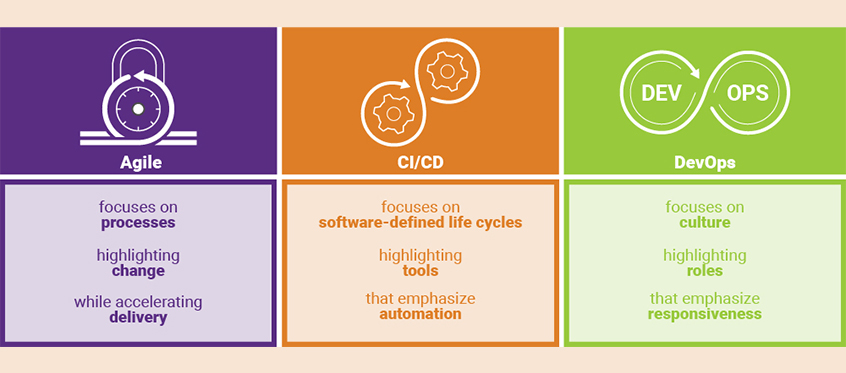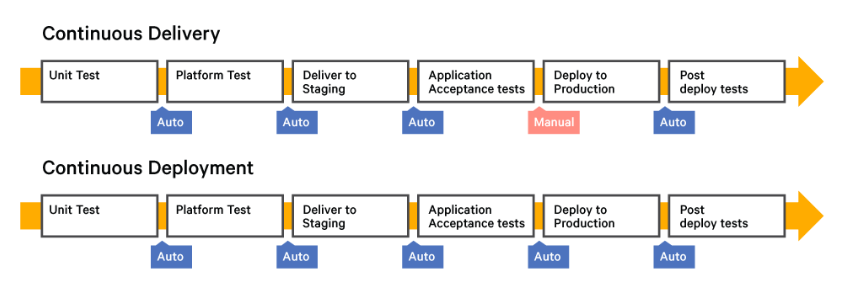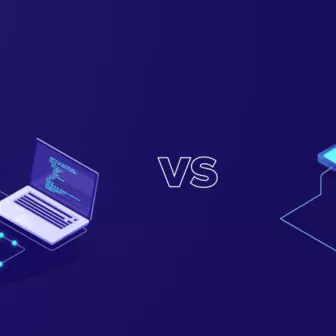Great production is marked with precision, on-time delivery, and reliability whereas building a product includes modernizing the approach with automation.
The adoption of CI/CD pipelines within the DevOps practices has indicated a remarkable growth for many enterprises. Being at the core of DevOps, the production cycles of CI (Continuous Integration) and CD (Continuous Delivery) are both said to be enhanced by a large margin.
In this article, we have highlighted how the architecture of CI/CD pipelines can build better products and deliver in a more efficient manner along with reaping benefits in turn. We have tried to showcase how the streamlining of CI/CD pipelines with DevOps can lead to agile development. And further, how we can take the next step with Cloud-native.

Continuous Deployment or Continuous Delivery?
Sure, it's a confusing state to be if you are just learning about the CI/CD pipeline and its elements. You might encounter dilemmas in context to continuous deployment and continuous delivery when it comes to software production. Here’s a crude explanation to it:
Continuous delivery is when you ensure that the production is ready for release. It begins by sending the production to user acceptance test (UAT) phase and then clearing each stage. However, continuous deployment is when you automate your release and build the production environment around it. It is generally the next step in continuous delivery. The continuous deployment should be a goal for organizations who want to regulate their ecosystem in an orderly manner.
Therefore, continuous delivery can be a necessity for DevOps practices while continuous deployment might not be a fit for all.

Phases of Building a CI/CD Pipeline
The complete process of initiating the development and delivering the product entails four main phases that lead to the final delivery and thus, maintaining a continuous delivery.
Phase 1: Change
Developers must know where and how to commit their code. If a change is triggered by a source code repository, the CI/CD tool receives a notification that corresponds to it in the pipeline. Thus, that change is committed to the repository. Proper execution of this change becomes a necessity in the pipeline.
Phase 2: Build
With all changes in place, the code is then integrated into a build. For a program written in languages like Java or Go has to be compiled first. But Ruby, Python or JavaScript can skip this step.
As a common practice, often the software is deployed with Docker. Thus, the stages of CI/CD pipeline also build in the Docker containers accordingly.
Phase 3: Automate Testing Stage
Validating the code and its behavior is where automation is applied against the build. The QA process is an essential step in preventing bugs and errors. However, it might involve multiple stages of testing for large projects with complex codes. But it essentially helps in tracking the code and maintaining a constant feedback loop.
Phase 4: Deploy
A running build that passes the stage of testing is then mirrored as closely as possible in multiple environments. It starts with internal production or the ‘beta’ version of the actual production. With real-time monitoring in the agile development model, teams can now automate the approved changes that in turn accelerate the production in one click. This makes it easier to streamline the pipeline and achieve the fundamentals of DevOps.
What differentiates a Good Pipeline?
You can distinguish a good CI/CD pipeline on the following parameters:
Speed
Traditional CI/CD pipelines have limited capacity to withhold the production. When building, testing, and deploying a simple code, the developers might have a hard time committing due to the queue created in the pipeline. On the other hand, setting up a new pipeline is an arduous process of scaling the infrastructure whereas reusing the existing one might create friction. In such cases, the speed of the development cycle loses the grip and productivity falls to a minimum. This is where implementing principles of serverless can be a solution.
With a cloud infrastructure based on the lines of microservices, the CI/CD pipeline can make the best of the development workflows and make the process of reviewing, restoring more productive and moving.
Reliability
Failures in a pipeline can be best avoided by having a reliable output to the production input. In order to achieve that, you have to cross-check the documentation and make sure that the production objectives align with the stakeholders. A reliable CI/CD pipeline invites greater communication and collaboration between teams and thus, a good pipeline.
Accuracy
Automation seems to be the tip of the iceberg. When we automate our production pipeline, it accurately runs the workflow. Often, there is a common practice to automate only one part of the process, the CI phase, and the deployment is carried out manually. In such cases, CI/CD tools can be put to use and the complex workflows can also be untangled to an extent.
Best Practices in Review
Tracking and version control
Visibility of the progress and the transparency among distributed teams is of utmost importance. Jira and Bugzilla are tools that can help you gain control over the tracking of activities and changes in the code-base. Also, the integrated teams share a common repository which can be improved with a degree of visibility.
Build Once
Multiple software built can create friction and bottleneck the pipeline. For a successful implementation of CI, the first step is to package the software in an environment that eliminates errors. A clear view of the build can promote your binaries.
Security
Automation comes on the cost of massive security needs. The CI/CD systems have access to your codebase and deployment environments. This means, the pipeline is vulnerable to hacking and thus massive business reputation is on the line. A secure network needs to be installed that ensures that the activities from development to deployment are contained in a safe ecosystem called, DevSecOps.
CI/CD Feedback Loop
The whole idea of having a CI/CD pipeline is to automate the process and reduce it to minutes. With minimum human errors, automation removes the risks and increases the visibility of the pipeline. The transparent and exposed interface between developers makes way for a communication network that creates a feedback loop within the CI/CD pipeline. This also helps in building shared libraries of code and work effectively.
Measure Continuous Delivery
While automation facilitates the process, it is on us to use it effectively and according to the requirements of a particular project. Instead of going by the textbooks, the metrics and dashboard should be customized as per relevancy. The insights from the summaries produced by the CI/CD dashboards can be optimized to deploy better production cycles and build a stronger product.
Pushing Beyond DevOps: Cloud-Native
Cloud-native is the next big leap in the tech world that is essentially built to encourage the Agile and DevOps teams. The complex environment introduces experimentation in the process and enables new combinations that lead to the right deployment strategy with new features at hand.
Thus, the Cloud-native DevOps is nothing but empowering the teams to adopt new technologies and add value to the end product for the customers. When the DevOps team adopt cloud-native, they do not migrate to a new level, but evolve within the same environment and get equipped with newer core competence and can evaluate new approaches, too.
It can surely get too much to handle with cloud-native offering velocity and scale; while maintaining stability with the increased speed of CI/CD pipelines, but the end results are always gratifying.
Conclusion
DevOps practices focus on understanding elements like configuration and orchestration of a proper CI/CD pipeline, while Cloud-native brings the fragmentation of an application into tens, hundreds, even thousands of microservices, performing tasks independently. Together they hold the potential to contribute to the successful implementation and production of software products for an organization. It is our belief that with a more responsive and automated environment integrated with CI/CD practices, we can achieve the highest level of agile development.
Share your views on our social networks: Facebook, LinkedIn, and Twitter.
Subscribe
Related Blogs
Serverless vs Managed Services: Which One to Choose

When you decide to build an application in the cloud, you need to consider several factors. One of the most important…

Over the past few years, the cloud industry has gone through an extreme change with the transformation of serverless…
Putting The Serverless Trend Under a Microscope

Flexible. Scalable. Economical. These terms essentially sum up the advantages of serverless computing, an architecture that…




